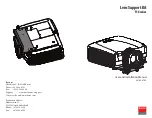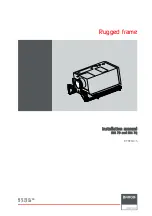
QTS-6000 Series
Analog Transmitter/Sensor
B71050-021-000-RB.doc
ELECTROCHEMICAL TRANSMITTER
JUL. 18, 2007
PRODUCT MANUAL
15
9. FIELD TROUBLE SHOOTING
9.1 Sensor Life
The response to gas of electrochemical sensors will reduce with time due to oxidation on the electrodes.
The rate of reduction is dependent upon such factors as ambient temperature, humidity, and exposure to gas.
In order to compensate for this, the gain of the transmitter can be increased when the unit is calibrated in the
field by adjusting the gain (span) potentiometer. If the potentiometer adjustment is insufficient, the gain
jumper may be moved to one higher gain position, i.e. JP4 to JP5, or JP5 to JP6.
*CAUTION*
The gain jumper should not be moved by more than one position, i.e., DO NOT move
JP4 to JP6, as this could increase the gain too much causing the amplification of
sensor noise, resulting in unacceptable jitter on the 4-20 mA output.
If the span signal cannot be achieved by adjusting the gain, or the increase in gain results in unacceptable
jitter on the output, then the sensor must be replaced.
9.2 Transmitter Electronics
*WARNING* STATIC ELECTRICITY - Installation, wiring, configuration, or other activity may
require handling or disassembly of the transmitter circuit card assemblies (CCA).
Handling of a CCA without proper precautions can expose the electronic components
to the possible damage from static electricity discharge.
Try to ensure you are grounded when handling a CCA. If continuous grounding is
not practical, touch some metal item, which is known to be grounded. Avoid
walking around after this as you can regenerate a static charge. Note that the
smallest static discharge, which is noticeable by humans, is 3,000 Volts. A
noticeable, significant discharge may be as high as 30,000 Volts
The two CCAs are the lowest level of field replaceable assembly. These assemblies must be replaced with
the power removed from the transmitter. See Figure 11 for an exploded view of the transmitter CCAs and
associated hardware, and for details on the disassembly and reassembly procedures.
The only life limited component in the transmitter electronics is a lithium battery. This battery is used to
provide a bias voltage to certain types of electrochemical sensors only when the transmitter is unpowered.
In the unpowered condition the lithium battery will have a lifetime of at least six months. In the powered
condition the lifetime is expected to be at least ten years.
The lithium battery is soldered into the lower CCA, and therefore if it is necessary to replace it in the field
the Lower CCA must be replaced.




































